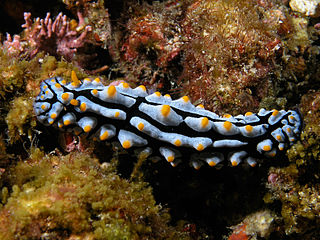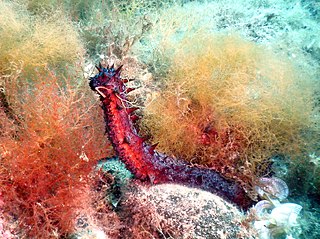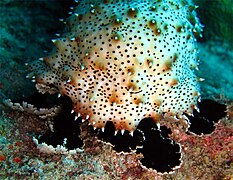
Holothuriida is an order of sea cucumbers. Taxa within the order Holothuriida were previously classified in the order Aspidochirotida, which was determined to be polyphyletic in 2017. Some taxa were also reclassified into the clades Synallactida and Persiculida.

Phyllidia varicosa is a species of sea slug, a dorid nudibranch, a shell-less marine gastropod mollusc in the family Phyllidiidae.

Holothuriidae is a family of sea cucumbers, a type of echinoderm.

Holothuria atra, commonly known as the black sea cucumber or lollyfish, is a species of marine invertebrate in the family Holothuriidae. It was placed in the subgenus Halodeima by Pearson in 1914, making its full scientific name Holothuria (Halodeima) atra. It is the type species of the subgenus.

Stichopus chloronotus is a species of sea cucumber. Common names include the greenfish sea cucumber, the spiky sea cucumber and the black knobby sea cucumber. It is native to the Indo-Pacific region. It has a wide range and is abundant and the IUCN lists it as being of "Least Concern".

Holothuria scabra, or sandfish, is a species of sea cucumber in the family Holothuriidae. It was placed in the subgenus Metriatyla by Rowe in 1969 and is the type species of the subgenus. Sandfish are harvested and processed into "beche-de-mer" and eaten in China and other Pacific coastal communities.

Holothuria tubulosa, the cotton-spinner or tubular sea cucumber, is a species of sea cucumber in the family Holothuriidae. It is the type species of the genus Holothuria and is placed in the subgenus Holothuria, making its full name Holothuria (Holothuria) tubulosa.

Bohadschia argus, the leopard sea cucumber, leopardfish, or tigerfish, is a species of sea cucumber in the family Holothuriidae. It is native to the tropical Western Indo-Pacific region.

Bohadschia marmorata, commonly known as the brown sandfish or chalky cucumber, is a species of sea cucumber in the family Holothuriidae. It lives on the seabed in shallow waters in the Indo-Pacific region.

Colochirus quadrangularis, commonly known as the thorny sea cucumber, is a species of sea cucumber in the family Cucumariidae. It is found in shallow seas in tropical parts of the Indo-Pacific region.

Colochirus robustus, commonly known as the robust sea cucumber or the yellow sea cucumber, is a species of sea cucumber in the family Cucumariidae. It is found in shallow seas in tropical parts of the central Indo-Pacific region. C. robustus belongs to the class Holothuroidea, a group of echinoderms called sea cucumbers and known for unusual behavior including evisceration, asexual reproduction, and regeneration. The robust sea cucumber has a soft body and lacks a spine, but it does have an endoskeleton consisting of microscopic spicules, or ossicles, made of calcium carbonate. C. robustus has a respiratory tree that allows it to extract oxygen for respiration, using the anus to pump water. The robust sea cucumber is an important dietary staple for many East and Southeast Asian populations, and has been used for medicinal purposes for hundreds of years. Recent research suggests that peptides from C. robustus enhance the activity of the immune system.
Holothuria spinifera, the brown sandfish, is a species of sea cucumber in the family Holothuriidae. It is placed in the subgenus Theelothuria, making its full name Holothuria (Theelothuria) spinifera. In India it is known as cheena attai or raja attai. It lives in tropical regions of the west Indo-Pacific Ocean at depths ranging from 32 to 60 metres. It is fished commercially to produce beche-de-mer.

Holothuria floridana, the Florida sea cucumber, is a species of marine invertebrate in the family Holothuriidae. It is found on the seabed just below the low tide mark in Florida, the Gulf of Mexico, the Bahamas and the Caribbean.

Holothuria edulis, commonly known as the edible sea cucumber or the pink and black sea cucumber, is a species of echinoderm in the family Holothuriidae. It was placed in the subgenus Halodeima by Pearson in 1914, making its full scientific name Holothuria (Halodeima) edulis. It is found in shallow water in the tropical Indo-Pacific Ocean.

Synapta maculata, the snake sea cucumber, is a species of sea cucumber in the family Synaptidae. It is found in shallow waters in the tropical Indo-Pacific Ocean. Sometimes growing as long as 3 m (10 ft), it is one of the longest sea cucumbers in the world.

Holothuria fuscocinerea, the ashy pink sea cucumber, is a species of sea cucumber in the family Holothuriidae. It is placed in the subgenus Stauropora, making its full name Holothuria (Stauropora) fuscocinerea. It is native to shallow water in the tropical and sub-tropical Indo-Pacific.

Holothuria fuscopunctata, the elephant trunkfish, is a species of sea cucumber in the family Holothuriidae native to shallow water in the tropical Indo-Pacific. It is placed in the subgenus Microthele, making its full name Holothuria (Microthele) fuscopunctata.

Synaptula recta, sometimes known as the gut-like sea cucumber, is a species of sea cucumber in the family Synaptidae in the phylum Echinodermata. It occurs in shallow water in the tropical Indo-Pacific region.

Holothuria hilla is a species of sea cucumber in the subgenus Mertensiothuria of the genus Holothuria. Some common names include the contractile sea cucumber, the sand sifting sea cucumber and the tigertail sea cucumber, and in Hawaii it is known as the light spotted sea cucumber. It is found in the Indo-Pacific region and the Red Sea.

Actinopyga varians, the Pacific white-spotted sea cucumber or Hawaiian sea cucumber, is a species of sea cucumber in the family Holothuriidae. It is found in the Pacific Ocean near Hawaii and also in the Indo-Pacific Ocean.

























